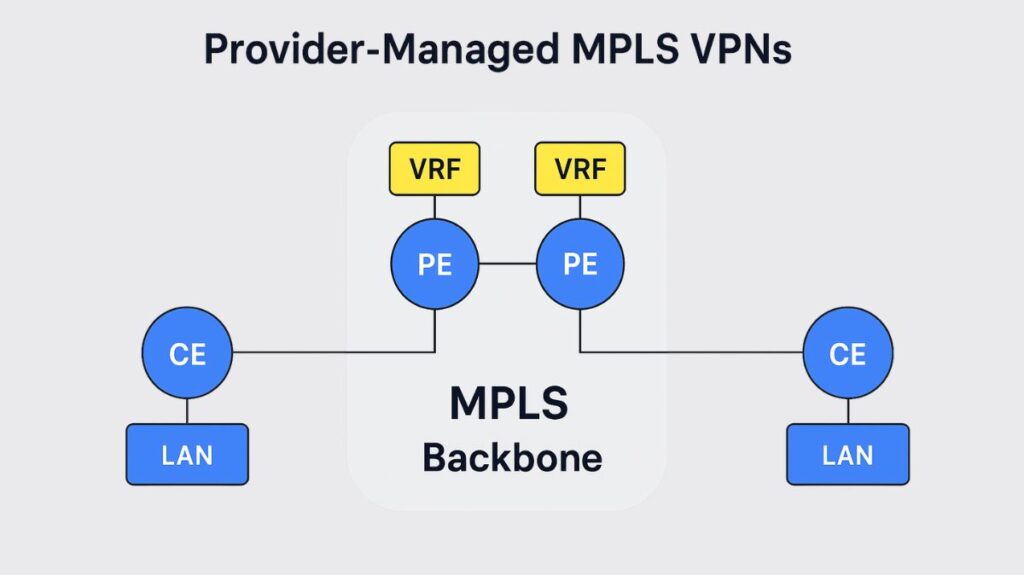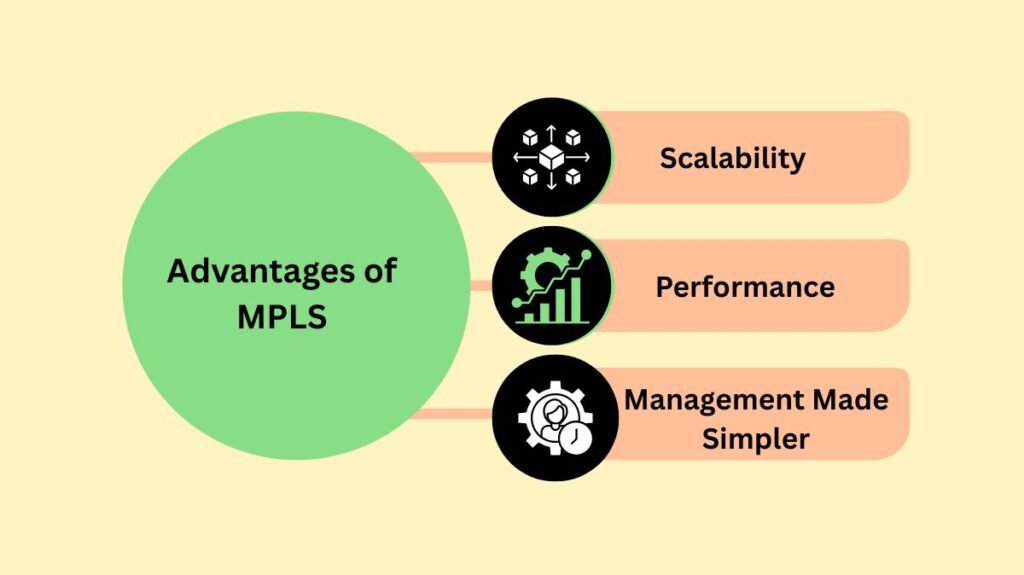MLPS managed network providers
Provider-Managed Multiprotocol Label Switching (MPLS) Virtual Private Networks (VPNs) are a highly significant Wide Area Network (WAN) technology, primarily operated and maintained by service providers (SPs) to deliver private networking services to their customers. This solution utilizes the SP’s MPLS backbone to create virtual networks that are secure and scalable.

Overview and Purpose
The fundamental idea is that the service provider controls the network infrastructure, taking care of the customer’s traffic isolation and routing through Layer 3 VPN technology.
Service Model: The MPLS backbone is constructed and maintained by the provider, which also handles VPN routing and isolation. The whole Layer 3 VPN infrastructure is outsourced by this service; from the standpoint of the client, the SP network functions as a single virtual switch.
Privacy and Isolation: Even when packets from several customers travel over the same shared network devices and channels, MPLS VPNs use internal MPLS logic to establish a private network and maintain the logical separation of client data. This offers privacy and security without requiring encryption that is controlled by the user. It is crucial to remember that, in contrast to Internet VPNs, MPLS VPNs do not by default rely on encryption.
Performance: Using Quality of Service (QoS) features and Service Level Agreements (SLAs), providers can guarantee performance and traffic control. This is a crucial feature.
Also Read About RJ12 Connectors, Applications, and Key Differences from RJ11
Architecture and Components
Both the customer’s and the provider’s routers play distinct functions in the architecture:
- Customer Edge (CE) routers are directly connected to Provider Edge (PE) routers, which are located at the edge of the service provider’s network. As packets enter and exit the MPLS network, PE routers are in charge of adding and removing MPLS labels. In the provider network, they are the final link.
- Customer Edge (CE) routers are owned by the customer and are situated at the customer’s location. They connect to the provider network, but they usually don’t take part in MPLS operations.
- Core routers in the service provider network are known as provider (P) routers. Their main responsibility is to connect the PE routers by passing data via label switching. P routers typically don’t know which VPNs belong to which customers.
Layer 3 Functionality and Traffic Isolation
Usually, Layer 3 VPNs, provider-managed services require the service provider to know the client’s IP address.
Traffic Isolation (VRF)
The PE routers’ Virtual Routing and Forwarding (VRF) instances are used to separate traffic.
- A derived Cisco Express Forwarding (CEF) table, an IP routing table, and a collection of interfaces that utilise this forwarding table make up a VRF.
- Even when several clients share a subnet, the usage of VRFs guarantees that data is not transmitted outside the VPN, avoiding issues with duplicate IP addresses.
- A Route Distinguisher (RD), which extends the IP address to identify which VPN it belongs to, must be specified in order to configure a VRF.
Forwarding and Routing
Through a service provider network, many sites can connect transparently to the MPLS VPN capability.
- PE-CE Routing: CE and PE routers allow dynamic routing protocols like BGP, OSPF, and EIGRP by establishing neighbour relationships via the access link.
- Internal SP Routing (MP-BGP): The router that employs Multiprotocol BGP (MP-BGP) disperses the VPN routing data across PE routers within the core. To ensure that routes are only broadcast to the appropriate PE routers that are part of the same VPN, MP-BGP filters the import and export process of routes using extended communities, or Route Targets.
- MPLS Forwarding: The ingress PE router assigns MPLS labels to packets as they enter the network. These brief labels are used to forward packets along a Label Switched Path (LSP) between the P routers, which accelerates and modifies traffic flows.
Also Read About What is Virtual Router Redundancy Protocol & How VRRP Works
Key Advantages of MPLS

MPLS VPNs are regarded for a number of important features:
- Scalability: The design can connect several sites because it is very scalable.
- Performance: MPLS prioritises latency-sensitive applications like phone and video by supporting comprehensive Quality of Service (QoS) and traffic engineering (TE) capabilities.
- Management Made Simpler: The supplier takes care of the intricate backbone operations, saving customers the trouble of maintaining the underlying MPLS network or setting up separate IPsec tunnels for site connectivity.
MPLS VPN Service Types
Two types of MPLS VPN solutions are typically offered by service providers:
- By redistributing routes across the MPLS network, the service provider actively engages in customer routing with Layer 3 MPLS VPN (L3VPN). If the client want to completely outsource Layer 3 routing administration, this is perfect.
- Layer 2 MPLS VPN (L2VPN): The provider uses technologies like Virtual Private LAN Service (VPLS) or Virtual Private Wire Service (VPWS) to simulate a Layer 2 service via the MPLS backbone, but it does not handle customer routing.
Also Read About What Is A VPN Tunnels? How It Works, VPN Tunneling Protocols
